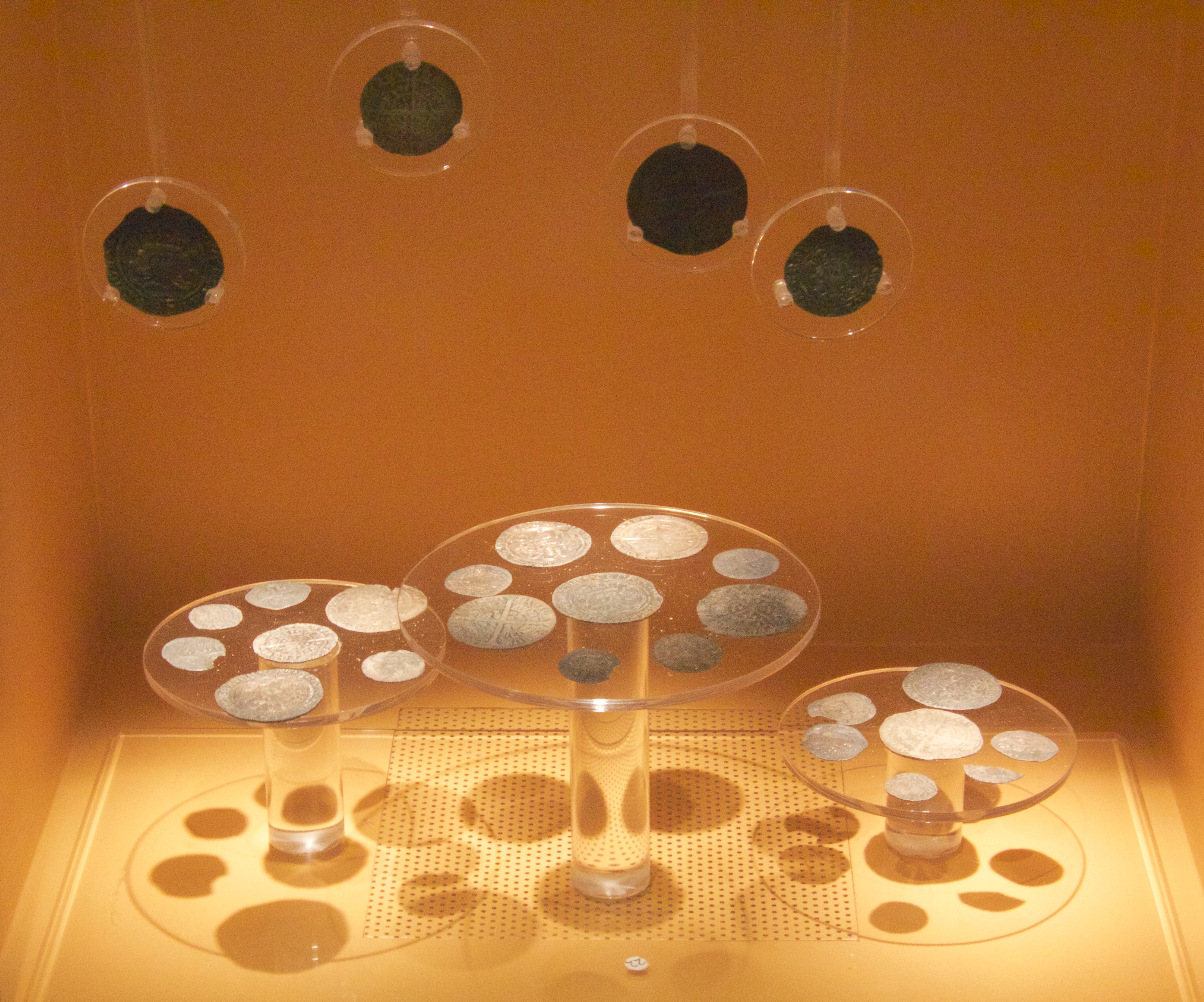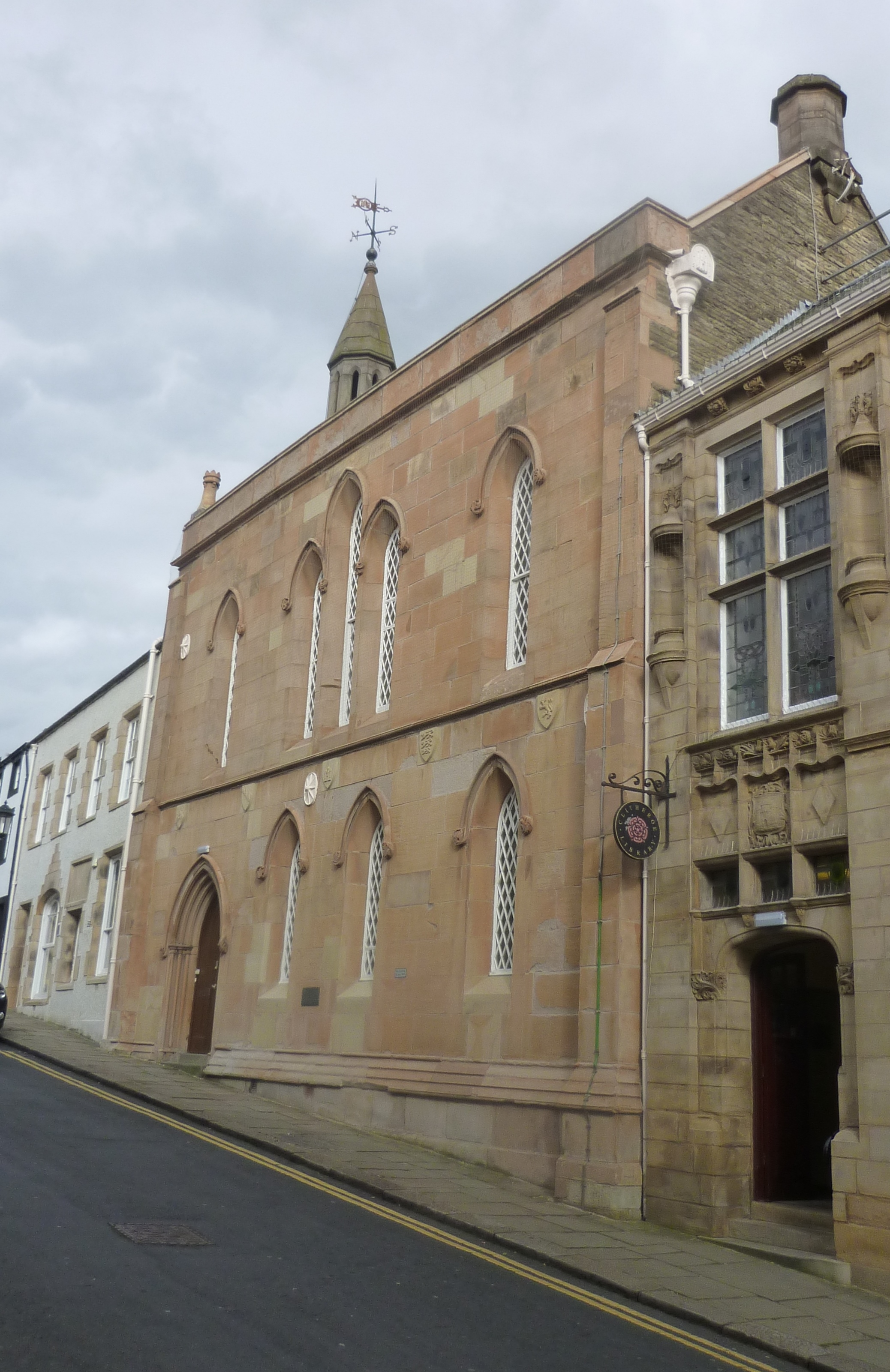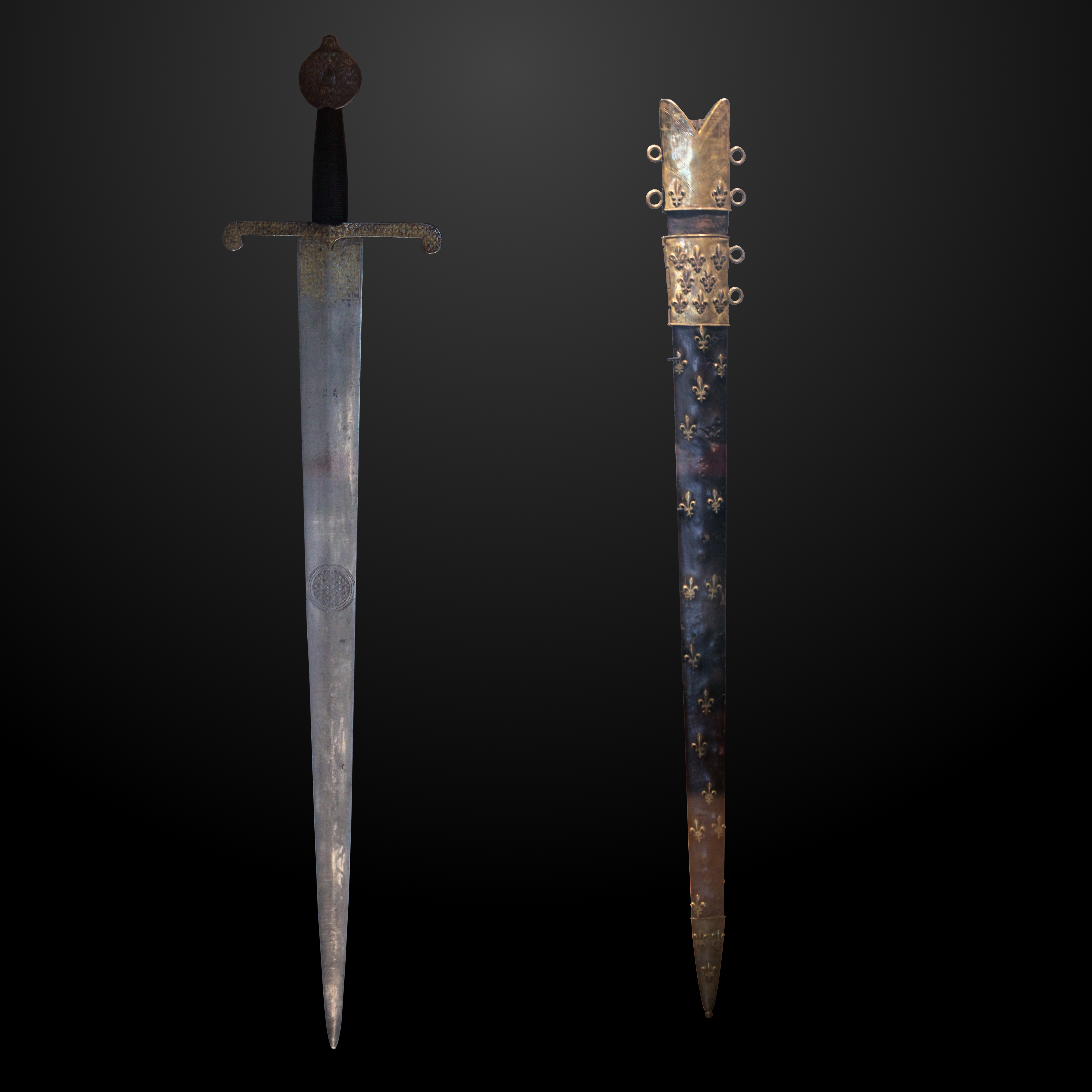|
Mitton Hoard
The Mitton Hoard is a hoard of silver coins found near Clitheroe in Lancashire, England, in 2006 or 2009. The hoard is now in Clitheroe Castle Museum. The documented treasure consisted of 11 silver coins or parts of coins. Local history Mitton is divided into two villages, Great Mitton and Little Mitton. This find was first detected to the west of Great Mitton between the River Hodder and the River Ribble. The find was near a bend in the River Hodder. One source says that these coins were found in 2006 whilst another says that the coins were found using a metal detector on Monday 7 September 2009. The treasure was declared to be treasure and it was obtained by the museum services. The hoard is now on display in the Clitheroe Castle Museum. The hoard The hoard can be dated from the date of the last coin that was included in the hoard and this came from the 1420s. Three of the coins were the oldest and they dated to the reign of Edward I or Edward II. The English silver is 97.5 ... [...More Info...] [...Related Items...] OR: [Wikipedia] [Google] [Baidu] |
Clitheroe Castle Museum Editathon 065
Clitheroe () is a town and civil parish in the Borough of Ribble Valley, Lancashire, England; it is located north-west of Manchester. It is near the Forest of Bowland and is often used as a base for tourists visiting the area. In 2018, the Clitheroe built-up area had an estimated population of 16,279. The town's most notable building is Clitheroe Castle, which is said to be one of the smallest Norman keeps in Great Britain. Several manufacturing companies have sites here, including Dugdale Nutrition, Hanson Cement, Johnson Matthey and Tarmac. History The name ''Clitheroe'' is thought to come from the Anglo-Saxon for "Rocky Hill", and was also spelled ''Clyderhow'' and ''Cletherwoode'', amongst others. The town was the administrative centre for the lands of the Honour of Clitheroe. The Battle of Clitheroe was fought in 1138 during the Anarchy. These lands were held by Roger de Poitou, who passed them to the De Lacy family, from whom they passed by marriage in 1310 or 1311 to ... [...More Info...] [...Related Items...] OR: [Wikipedia] [Google] [Baidu] |
Edward II Of England
Edward II (25 April 1284 – 21 September 1327), also called Edward of Caernarfon, was King of England and Lord of Ireland from 1307 until he was deposed in January 1327. The fourth son of Edward I, Edward became the heir apparent to the throne following the death of his elder brother Alphonso. Beginning in 1300, Edward accompanied his father on invasions of Scotland. In 1306, he was knighted in a grand ceremony at Westminster Abbey. Following his father's death, Edward succeeded to the throne in 1307. He married Isabella, the daughter of the powerful King Philip IV of France, in 1308, as part of a long-running effort to resolve tensions between the English and French crowns. Edward had a close and controversial relationship with Piers Gaveston, who had joined his household in 1300. The precise nature of their relationship is uncertain; they may have been friends, lovers, or sworn brothers. Edward's relationship with Gaveston inspired Christopher Marlowe's 15 ... [...More Info...] [...Related Items...] OR: [Wikipedia] [Google] [Baidu] |
2009 Archaeological Discoveries
9 (nine) is the natural number following and preceding . Evolution of the Arabic digit In the beginning, various Indians wrote a digit 9 similar in shape to the modern closing question mark without the bottom dot. The Kshatrapa, Andhra and Gupta started curving the bottom vertical line coming up with a -look-alike. The Nagari continued the bottom stroke to make a circle and enclose the 3-look-alike, in much the same way that the sign @ encircles a lowercase ''a''. As time went on, the enclosing circle became bigger and its line continued beyond the circle downwards, as the 3-look-alike became smaller. Soon, all that was left of the 3-look-alike was a squiggle. The Arabs simply connected that squiggle to the downward stroke at the middle and subsequent European change was purely cosmetic. While the shape of the glyph for the digit 9 has an ascender in most modern typefaces, in typefaces with text figures the character usually has a descender, as, for example, in . The mod ... [...More Info...] [...Related Items...] OR: [Wikipedia] [Google] [Baidu] |
Treasure Troves Of Medieval Europe
Treasure (from la, thesaurus from Greek language ''thēsauros'', "treasure store") is a concentration of wealth — often originating from ancient history — that is considered lost and/or forgotten until rediscovered. Some jurisdictions legally define what constitutes treasure, such as in the British Treasure Act 1996. The phrase "blood and treasure" has been used to refer to the human and monetary costs associated with massive endeavours such as war that expend both. Searching for hidden treasure is a common theme in legend; treasure hunters do exist, and can seek lost wealth for a living. Burial Buried treasure is an important part of the popular mythos surrounding pirates. According to popular conception, pirates often buried their stolen fortunes in remote places, intending to return for them later (often with the use of treasure maps). There are three well-known stories that helped popularize the myth of buried pirate treasure: "The Gold-Bug" by Edgar Allan Poe, ... [...More Info...] [...Related Items...] OR: [Wikipedia] [Google] [Baidu] |
Treasure Troves In England
Treasure (from la, thesaurus from Greek language ''thēsauros'', "treasure store") is a concentration of wealth — often originating from ancient history — that is considered lost and/or forgotten until rediscovered. Some jurisdictions legally define what constitutes treasure, such as in the British Treasure Act 1996. The phrase "blood and treasure" has been used to refer to the human and monetary costs associated with massive endeavours such as war that expend both. Searching for hidden treasure is a common theme in legend; treasure hunters do exist, and can seek lost wealth for a living. Burial Buried treasure is an important part of the popular mythos surrounding pirates. According to popular conception, pirates often buried their stolen fortunes in remote places, intending to return for them later (often with the use of treasure maps). There are three well-known stories that helped popularize the myth of buried pirate treasure: "The Gold-Bug" by Edgar Allan Poe, ... [...More Info...] [...Related Items...] OR: [Wikipedia] [Google] [Baidu] |
History Of The English Penny (1154–1485)
The history of the English penny from 1154 to 1485 covers the period of the House of Plantagenet, up to the Battle of Bosworth Field which brought about the beginning of the Tudor period. The Plantagenet period saw an overall rise in quality of the coinage but saw a decline in the number of mints used to produce coins. The first years of the reign of Henry II saw no change in the production of coins from the reign of Stephen, until the Tealby penny was introduced, produced from 1158 to 1180. These coins' weight and quality of silver were good, but the overall production was poor, and so in 1180 the short-cross penny was introduced. The coinage during the reigns of Richard I and John remained unchanged. In 1247, under Henry III, the long-cross penny replaced the short-cross to deter clipping. In 1279 Edward I began a new coinage which was admired and imitated on the continent and included the addition of the farthing, halfpenny and groat as well as making clipping easier to d ... [...More Info...] [...Related Items...] OR: [Wikipedia] [Google] [Baidu] |
List Of Hoards In Britain
The list of hoards in Britain comprises significant archaeological hoards of coins, jewellery, precious and scrap metal objects and other valuable items discovered in Great Britain ( England, Scotland and Wales). It includes both hoards that were buried with the intention of retrieval at a later date (personal hoards, founder's hoards, merchant's hoards, and hoards of loot), and also hoards of votive offerings which were not intended to be recovered at a later date, but excludes grave goods and single items found in isolation. The list is subdivided into sections according to archaeological and historical periods. Neolithic hoards Hoards dating to the Neolithic period, approximately 4000 to 2000 BC, comprise stone weapons and tools such as axeheads and arrowheads. Such hoards are very rare, and only a few are known from Britain. Bronze Age hoards A large number of hoards associated with the British Bronze Age, approximately 2700 BC to 8th century BC, have been foun ... [...More Info...] [...Related Items...] OR: [Wikipedia] [Google] [Baidu] |
Constable Of France
The Constable of France (french: Connétable de France, from Latin for 'count of the stables') was lieutenant to the King of France, the first of the original five Great Officers of the Crown (along with seneschal, chamberlain, butler, and chancellor) and the commander-in-chief of the Royal Army. He was, at least on paper, the highest-ranking member of the French nobility. The was also responsible for military justice and served to regulate the Chivalry. His jurisdiction was called the Constabulary (; or in modern French orthography which sticks closer to the correct pronunciation: ). The office was established by King Philip I in 1060 AD, with Alberic becoming the first Constable. The office was abolished in 1627, with an edict, by Cardinal Richelieu, upon the death of , in order to strengthen the immediate authority of the King over his army. The position was officially replaced by the purely ceremonial title "Dean of Marshals" (), who was in fact the most senior "Marshal ... [...More Info...] [...Related Items...] OR: [Wikipedia] [Google] [Baidu] |
Gaucher V De Châtillon
Gaucher V de Châtillon ( 1249 in Châtillon-sur-Marne – 1329), Lord of Châtillon, Count of Porcien, was constable of Champagne in 1284 and then Constable of France (1302–1329) during the reigns of five different kings. He was also tutor to the future Louis X of France and his primary minister. Biography Gaucher was the son of Gaucher IV de Châtillon and Isabelle de Villehardouin, and was the grandson of Hugues de Châtillon, Count of Blois and Saint-Pol. In 1284, King Philip III of France named Gaucher, Constable of Champagne. He traded Philip IV for the county of Chatillon in return for Crecy in 1290, however in 1303 Philip forced the return of the county in exchange for Château-Porcien. Gaucher kept the castle of Châtillon, which was reserved for him and his descendants. In 1291, Gaucher repelled the army of Count Henry III of Bar, son-in-law of King Edward I of England. He fought the English in Guyenne in 1296. In 1302, during the conflict between Pope Bon ... [...More Info...] [...Related Items...] OR: [Wikipedia] [Google] [Baidu] |
Henry VI Of England
Henry VI (6 December 1421 – 21 May 1471) was King of England and Lord of Ireland from 1422 to 1461 and again from 1470 to 1471, and disputed King of France from 1422 to 1453. The only child of Henry V, he succeeded to the English throne at the age of nine months upon his father's death, and succeeded to the French throne on the death of his maternal grandfather, Charles VI, shortly afterwards. Henry inherited the long-running Hundred Years' War (1337–1453), in which his uncle Charles VII contested his claim to the French throne. He is the only English monarch to have been also crowned King of France, in 1431. His early reign, when several people were ruling for him, saw the pinnacle of English power in France, but subsequent military, diplomatic, and economic problems had seriously endangered the English cause by the time Henry was declared fit to rule in 1437. He found his realm in a difficult position, faced with setbacks in France and divisions among the nobil ... [...More Info...] [...Related Items...] OR: [Wikipedia] [Google] [Baidu] |
Groat (coin)
The groat is the traditional name of a defunct English and Irish silver coin worth four pence, and also a Scottish coin which was originally worth fourpence, with later issues being valued at eightpence and one shilling. Name The name has also been applied to any thick or large coin, such as the ''Groschen'' (''grosso''), a silver coin issued by Tyrol in 1271 and Venice in the 13th century, which was the first of this general size to circulate in the Holy Roman Empire and other parts of Europe. The immediate ancestor to the groat was the French '' gros tournois'' or groat of Tours, which was known as the ''groot'' (Dutch for "great" or "large") in the Netherlands. The name also refers to a range of other European coins such as those of the Italian peninsula known as a ''grosso'' including the grosso of Venice and the Kraków grosz in Poland. Marco Polo referred to the groat in recounts of his travels to East Asia when describing the currencies of the Yuan Empire. His descripti ... [...More Info...] [...Related Items...] OR: [Wikipedia] [Google] [Baidu] |
Richard II Of England
Richard II (6 January 1367 – ), also known as Richard of Bordeaux, was King of England from 1377 until he was deposed in 1399. He was the son of Edward the Black Prince, Prince of Wales, and Joan, Countess of Kent. Richard's father died in 1376, leaving Richard as heir apparent to his grandfather, King Edward III; upon the latter's death, the 10-year-old Richard succeeded to the throne. During Richard's first years as king, government was in the hands of a series of regency councils, influenced by Richard's uncles John of Gaunt and Thomas of Woodstock. England then faced various problems, most notably the Hundred Years' War. A major challenge of the reign was the Peasants' Revolt in 1381, and the young king played a central part in the successful suppression of this crisis. Less warlike than either his father or grandfather, he sought to bring an end to the Hundred Years' War. A firm believer in the royal prerogative, Richard restrained the power of the aristocracy an ... [...More Info...] [...Related Items...] OR: [Wikipedia] [Google] [Baidu] |










